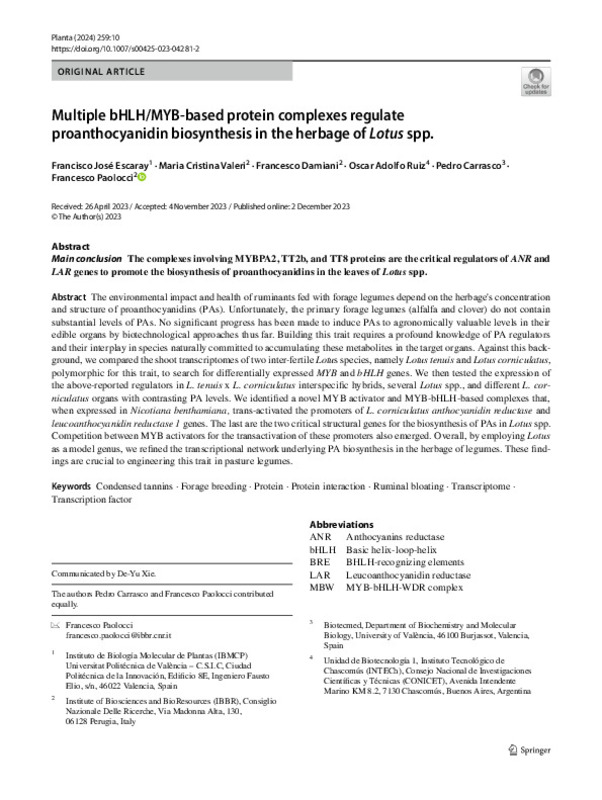Escaray, FJ.; Valeri, MC.; Damiani, F.; Ruiz, OA.; Carrasco, P.; Paolocci, F. (2024). Multiple bHLH/MYB-based protein complexes regulate proanthocyanidin biosynthesis in the herbage of Lotus spp. Planta. 259(1). https://doi.org/10.1007/s00425-023-04281-2
Por favor, use este identificador para citar o enlazar este ítem: http://hdl.handle.net/10251/203369
|
Título:
|
Multiple bHLH/MYB-based protein complexes regulate proanthocyanidin biosynthesis in the herbage of Lotus spp.
|
|
Autor:
|
Escaray, Francisco José
Valeri, Maria Cristina
Damiani, Francesco
Ruiz, Oscar Adolfo
Carrasco, Pedro
Paolocci, Francesco
|
|
Fecha difusión:
|
|
|
Resumen:
|
[EN] The environmental impact and health of ruminants fed with forage legumes depend on the herbage's concentration and structure of proanthocyanidins (PAs). Unfortunately, the primary forage legumes (alfalfa and clover) ...[+]
[EN] The environmental impact and health of ruminants fed with forage legumes depend on the herbage's concentration and structure of proanthocyanidins (PAs). Unfortunately, the primary forage legumes (alfalfa and clover) do not contain substantial levels of PAs. No significant progress has been made to induce PAs to agronomically valuable levels in their edible organs by biotechnological approaches thus far. Building this trait requires a profound knowledge of PA regulators and their interplay in species naturally committed to accumulating these metabolites in the target organs. Against this background, we compared the shoot transcriptomes of two inter-fertile Lotus species, namely Lotus tenuis and Lotus corniculatus, polymorphic for this trait, to search for differentially expressed MYB and bHLH genes. We then tested the expression of the above-reported regulators in L. tenuis x L. corniculatus interspecific hybrids, several Lotus spp., and different L. corniculatus organs with contrasting PA levels. We identified a novel MYB activator and MYB-bHLH-based complexes that, when expressed in Nicotiana benthamiana, trans-activated the promoters of L. corniculatus anthocyanidin reductase and leucoanthocyanidin reductase 1 genes. The last are the two critical structural genes for the biosynthesis of PAs in Lotus spp. Competition between MYB activators for the transactivation of these promoters also emerged. Overall, by employing Lotus as a model genus, we refined the transcriptional network underlying PA biosynthesis in the herbage of legumes. These findings are crucial to engineering this trait in pasture legumes.
[-]
|
|
Palabras clave:
|
Condensed tannins
,
Forage breeding
,
Protein
,
Protein interaction
,
Ruminal bloating
,
Transcriptome
,
Transcription factor
|
|
Derechos de uso:
|
Reconocimiento (by)
|
|
Fuente:
|
Planta. (issn:
0032-0935
)
|
|
DOI:
|
10.1007/s00425-023-04281-2
|
|
Editorial:
|
Springer-Verlag
|
|
Versión del editor:
|
https://doi.org/10.1007/s00425-023-04281-2
|
|
Código del Proyecto:
|
info:eu-repo/grantAgreement/EC//101082089/
|
|
Agradecimientos:
|
This study was partially supported by CNR (Italy)-CONICET (Argentina) 2021-2022 Bilateral Agreement, by the project Pict 2021-2023 from Agencia de Promocion Cientifica y Tecnologica (Argentina), by Margin Up, funded by the ...[+]
This study was partially supported by CNR (Italy)-CONICET (Argentina) 2021-2022 Bilateral Agreement, by the project Pict 2021-2023 from Agencia de Promocion Cientifica y Tecnologica (Argentina), by Margin Up, funded by the European Union's Horizon research and innovation program GA number no 101082089, and by the Italian Agritech National Research Center funded by the European Union Next-Generation EU (Piano Nazionale di Ripresa e Resilienza (PNRR)- Missione 4 Componente 2, Investitmento 1.4 - D.D. 1032 17/06/2022, CN00000022). In particular, our study represents an original paper related to the Spoke 4 "Multifunctional and resilient agriculture and forestry systems for the mitigation of climate change risks" of the PNRR project. However, views and opinions expressed are those of the authors and do not necessarily reflect those of the European Union or the European Research Agency (REA). Neither the European Union nor the granting authorities can be held responsible.
Open access funding provided by Consiglio Nazionale Delle
Ricerche (CNR) within the CRUI-CARE Agreement.
[-]
|
|
Tipo:
|
Artículo
|








